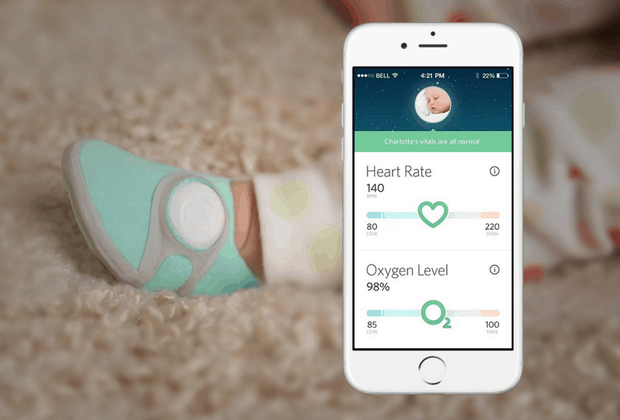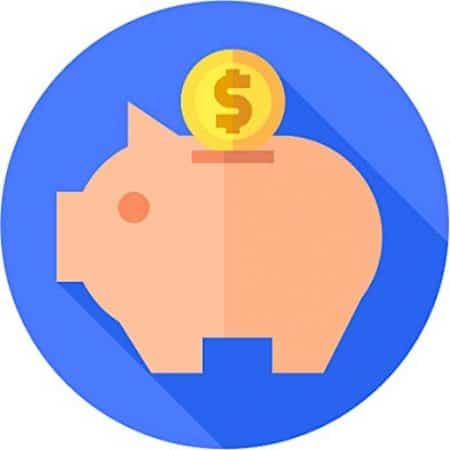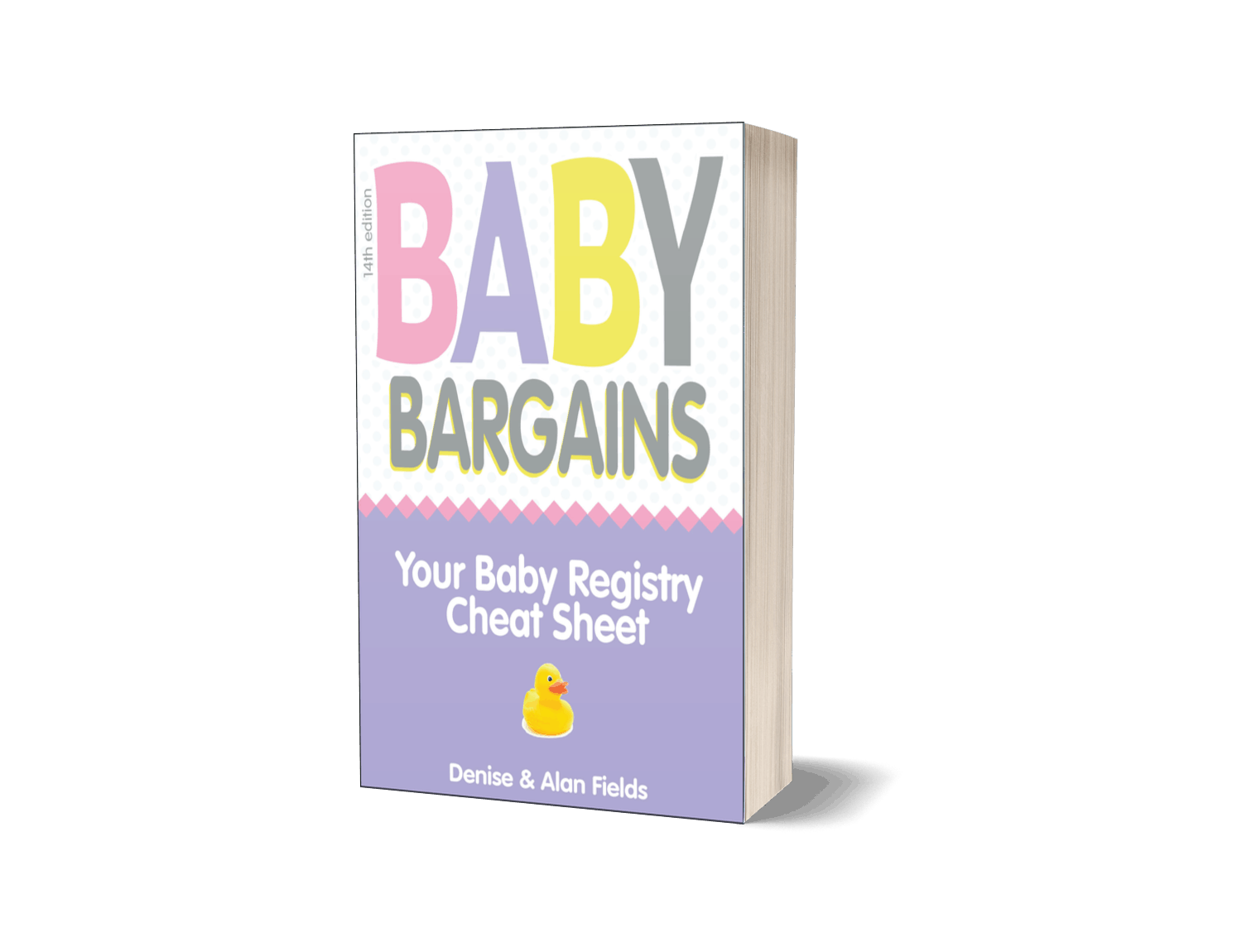Web site: OwletCare.com
Smart Baby Monitor: Owlet. The Owlet is a $300 “Smart Sock “ that constantly monitors a baby’s heart rate and oxygen saturation rate. The sock streams this info over Bluetooth to a wireless base station, which in turn sends alerts to an iOs device (an Android app BETA is available now). Even if you don’t have an iPhone, the base station can alert you if baby stops breathing with audible and visual alarms, the company claims. (It’s in its second iteration, so you’ll see the name Smart Sock 2.)
The sock itself has a rechargeable battery, which Owlet says lasts for several days on a charge. The Owlet is designed to be used for baby’s first year, although the company says it can work up to 18 months of age (there are three different sizes of the Owlet sock, which can be purchased for $40 from their site and switched out as baby grows).
Even though Owlet touts its technology as similar to that used by hospitals (pulse oximetry) with the implicit promise that this can save your baby during a medical emergency, the company offers this disclaimer:
Owlet is intended to provide peace of mind. It is not intended to diagnose, treat, mitigate, cure, or prevent any disease or condition. This is not a medical device and is not intended for use as a medical device or to replace a medical device. The Owlet Baby Monitor is only intended to assist you in tracking your baby’s wellbeing and is not intended to replace you as a caregiver. You are ultimately responsible for your baby. This device is not intended to cure, treat, or prevent any disease or health condition, including, but not limited to, Sudden Infant Death Syndrome (SIDS).
The Owlet has only been on the market for a short while, as of this writing. We’ve heard very little feedback from parents who’ve used an Owlet. New for 2018, Owlet will release a new app with real time heart rate info. You’ll be able to add other health information to the app for a more complete pickte.
So should you plunk down $300 for this device? No, in our opinion. We have two basic objections to devices like the Owlet:
1. Home monitors don’t prevent SIDS (Sudden Infant Death Syndrome). The American Academy of Pediatrics recommends against “at-home SIDS monitoring,” saying there is no proof that even medical grade devices can prevent SIDS. The science just isn’t there to justify the expense.
2. False alarms. According to an article on Live Science, there is a major potential for false alarms with monitors like the Owlet:
A major study of more than 1,000 infants, published in the Annals of the New York Academy of Sciences in 1988, found that instances of slowed heart rate and interrupted breathing during sleep are common in even healthy infants, and that most of these abnormalities vanish before the babies reach the ages during which SIDS peaks — between about 2 months and 4 months old. Thus, events that may cause at-home monitors to alert parents to potential danger are not linked with SIDS.
That’s right—healthy infants can set off a monitor like the Owlet even though there is no medical problem. And that’s the big irony with Owlet—a device that is pitched to help warn parents of a health issue with baby may actually induce more anxiety for the parent . . . when there is no problem at all.
Bottom line: if you are into gadgets and have a spare $300 lying around, then the Owlet might be interesting to play with. But don’t expect the Owlet to prevent or warn you of a medical condition with your child. By the way, they know it’s ridiculously expensive–they offer financing for it! Rating: Not Recommended.


 We obsess over gear for families . . . so you don't have to. Baby Bargains has one mission: help you find the best gear for your family and home with unbiased reviews by experts with 20 years of experience. At prices that don't break the bank. When you purchase a product from links on this site, we make a small affiliate commission. Learn more
We obsess over gear for families . . . so you don't have to. Baby Bargains has one mission: help you find the best gear for your family and home with unbiased reviews by experts with 20 years of experience. At prices that don't break the bank. When you purchase a product from links on this site, we make a small affiliate commission. Learn more 

I love the owlet. As a new parent I am comforted knowing I will be alerted if my boy’s heart rate or oxygen levels leave a normal range. We had one instance of a low oxygen alarm once in his first week, but it quickly returned to normal and we didn’t panic at all – we checked him and saw he was OK so we didn’t worry. But it was good to know in case a pattern emerged so we could follow up with our doctor.
I definately sleep 1000x better with the owlet – I know I would be up all night checking on him otherwise. You don’t need to be constantly checking the monitor and it doesn’t rely on movement to work. It is the best money I have ever spent on a baby product.
Thank you for comment! I just ordered the new version of this with the camera (it’s actually on my FSA store). Based on their review, I felt like I needed to search for another monitor.
I really appreciate your sharing your experience. We are expecting our first in March 🙂
First I want to start my review off with my personal background. I am a 30 year old first time dad and I’m also a fresh out school physician. My son was born by C-section in 2018 and was healthy. Even after all the research I’ve done, personally and in the medical field, on these monitors I decided on the owlet sock 2 for 3 reasons:
1) the readings that the alarms are set to go off at are at actual dangerous levels so the risk of “false alarms” is low.
2) a monitor is nothing more than that…a monitor. It will not help my baby in any way, BUT it can alert me so that I can try and help my baby.
3) I can actually sleep peacefully knowing that if anything changes with my baby I will know about it as soon as it happens and not when I wake up to tragedy that might could have been prevented.
Now for my personal story of why I’m thankful for the owlet monitor.
The first day home from the hospital, the owlet was on my baby’s foot and all was going well. The third day home from the hospital the owlet monitor went off blaring red and alarming at 2AM. My wife and I jumped out of bed and raced to the crib to find our baby laying there playing and content. I opened my phone and pulled up the app which was showing a heart rate of 263! I know not everyone on here is a doctor so I’ll tell you, that’s too high for a newborn and anyone else. Being the doctor I am, I grabbed my pediatric stethoscope and listened for myself. His heart was racing so fast I couldn’t even count the beats. We packed him up and took him to the pediatric emergency room. By the time we got there and got processed. Nothing was showing on the monitors. He was fine. We got a referral to pediatric cardiologist and we took him the next day. They put a 24 hour monitor on him and gave us a second monitor to put on him, after the 24 hour one came off, in case he had another episode later. Nothing happened. The 24 hour monitor showed normal activity. We put the owlet back on him after the medical grade one came off and it never alerted us to anything again Until that owlet alarm went off again 6 weeks later. We had held on to that other medical grade monitor and so my wife pulled up the owlet app while I hooked the medical grade monitor to him. The owlet app was getting readings of a heart rate in the 270s this time! I hit record on the medical monitor while I listened with my stethoscope again. This time we captured the event while it was happening. The owlet monitor was spot on with the recorded heart rate. 273bpm! With the recording the pediatric cardiologist was able to make the diagnosis of SupraVentricular Tachycardia (SVT) which is relatively benign, however, if a baby stays in SVT for long periods of time they can become hypoxemic (low oxygen) and it can stress the heart leading to early heart failure later in life. Most babies are asymptomatic (they don’t show any signs of distress) with SVT and ours was asymptomatic as well. We would have never known he was having SVT without that owlet and we could have allowed his heart to be strained over time without even realizing it. I am greatful to the owlet for the peace of mind alone. I am even more greatful to the owlet for allowing me to catch a heart condition early in my son that required medication so that he would not have any hidden problems later in life.
Thanks for sharing that story Turner. That was very powerful. We appreciate you taking the time to share it. Hope your little boy is doing well.